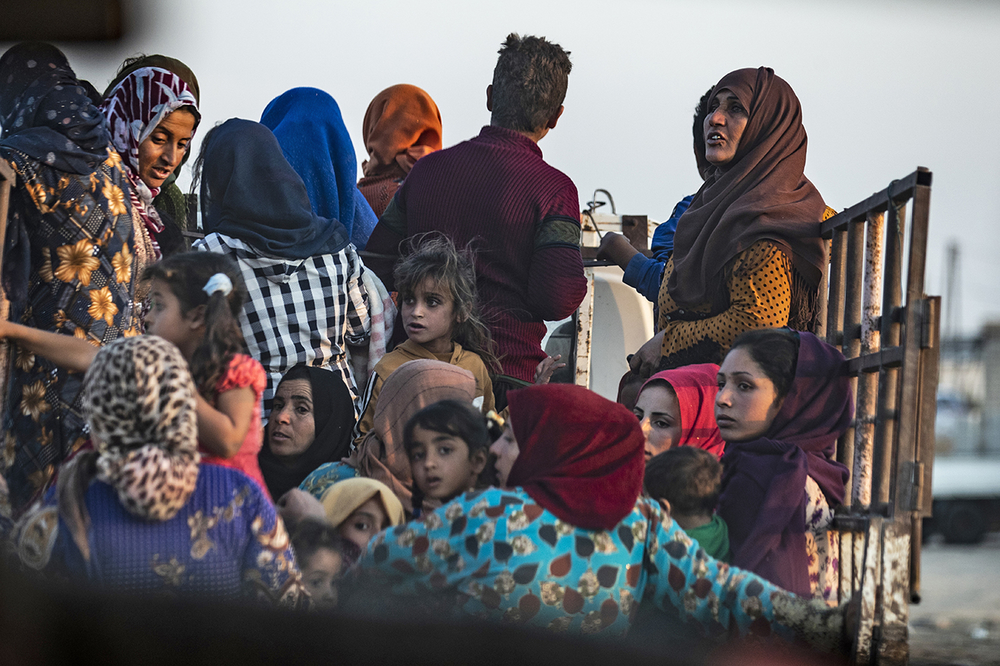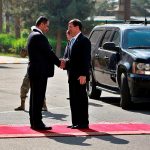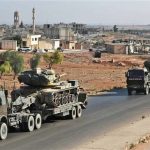When Turkey decided to plan and launch an operation in eastern Syria against the US-backed Syrian Democratic Forces it needed a way to avoid accusations of human rights abuses. It set upon an innovative solution: Arm and use Syrian rebel groups, many of them far-right religious extremists, to carry out Ankara’s war effort. That way whatever crimes take place, including looting and ethnic-cleansing of Kurdish civilians, of whom around 200,000 have been forced to flee, can be blamed on other groups.
Turkey’s military is not unique in using proxies, the Iranians and Saudis have used them in Yemen, and different militia groups have operated in Iraq and elsewhere. However Turkey is unique in that it is a member of NATO and its invasion of eastern Syria has little to do with NATO’s core mission. However the operation has been wrapped in the flag of NATO, which justified it in early October as addressing “security concerns” and the US has justified its abandoning of its own Kurdish allies because of pressure from its “Turkish NATO ally.” As such the operation has a cover of a NATO member country, even as 200,000 people were driven from their homes in what was a formally peaceful and stable area of northeast Syria, plunged into bombing and destruction by a NATO-member’s warplanes. That was likely not the vision founders of NATO had in mind
NATO grew out of the North Atlantic Treaty of 1949 and NATO’s website includes the foundational document that speaks to the alliance’s goals. It says the countries that join are “determined to safeguard freedom” and that it is founded “on the principles of democracy, individual liberty and the rule of law.” In addition the countries are supposed to “promote stability” with the intention of providing for the “collective defence and for the preservation of peace and security.”
The US has said that one of the issues it faced in protecting the SDF in eastern Syria and stopping Turkey’s offensive is that Turkey is a “NATO ally.” This put Washington in a bind. Since 2015 the US has been working closely with the SDF, a group that the US helped create. In fact the US partnered initially with the Kurdish People’s Protection Units (YPG) but the State Department was concerned that the YPG was linked to the Kurdistan Workers Party (PKK), a group that the US and Turkey both view as terrorists.
Washington thus created the SDF to be a more inclusive force, including Arabs and other groups, as well as elements of the YPG. It trained around 100,000 members of the SDF to fight ISIS and to secure eastern Syria. It also armed the SDF. However since 2017 Turkey has been threatening to attack the SDF, first in Manbij and later in the area that Turkey calls a “safe zone” along the border. Turkey decided that it has a right to take over a swath of eastern Syria, stretching for hundreds of kilometers ad thirty kilometers deep into Syria. This is the area where most Kurds in Syria live, so Turkey was arguing it has a right to take over most Kurdish cities. It said it had the right to do this due to “security concerns” about the PKK. There were no attacks on Turkey from Syria by the PKK, but Turkey invented this pretext of “fighting terrorism” as a way to sell its war to NATO.
By late July Turkey had presented its plans to Russia and by August it had forced the US to agree to a “security mechanism” that would allow Turkish forces to enter Syria on joint patrols. In September Turkey showed its plans to the UN General Assembly, saying it would settle millions of Arabs who are not from eastern Syria in Kurdish areas. Normally this would violate the rules of military occupation and international law, as well as going against NATO’s values. Ankara set on a very unique way to carry out its operation, using Syrian Arab rebel groups it had worked with in western Syria.
In early October Turkey brought together many of these groups under the Syrian National Army. Already Turkey had been working with them since 2015, in various forms. This included direct work with groups such as Faylaq Sham, and then working with the Turkish-backed Free Syrian army. It used these groups in operation Euphrates Shield when Turkey sought to stop the advance of the SDF past Manbij. Then, in precursor to the operation in eastern Syria, Turkey sent tens of thousands of these Syrian rebels into the Kurdish region of Afrin in January 2018. IN that operation around 160,000 Kurds were forced to flee and the jihadist elements among the Free Syrian Army looted Kurdish villages and towns, destroyed Kurdish statues and smashed graves of minorities such as Yazidis. Since the UN, Human Rights Groups and NATO paid little attention, Turkey knew that it could build on Afrin to do whatever it wanted in eastern Syria. In fact NATO had supported Turkey’s war in Afrin through statements supporting Ankara’s security concerns, even thought there was no evidence of any security threats to Turkey or attacks from Afrin. Turkey also told the US it was fighting ISIS in Afrin, even though there was no ISIS presence in Afrin.
To cover up the reality of the operation Turkey dubbed it “peace spring” and said it was creating a “safe zone.” However on the ground Turkey prepared a careful military plan. It was based on getting the US to leave border areas through ordering US President Donald Trump to move US forces aside. Trump decided to obey Turkey’s demands on October 6, withdrawing US forces, of which there were only around 24 men in observation posts. On October 9 Turkey began its assault through airstrikes on dozens of targets. While Turkish artillery and warplanes sought out SDF positions, some of them marked during the joint patrols in September that Turkey conducted with US approval, the Syrian National Army was sent to attack Tel Abyad and Sere Kaniye (Ras al-Ayn).
The use of the Syrian rebel proxies, under the banner of the SNA, was a tactic designed to provide Ankara plausible deniability from any subsequent claims of crimes in the operation. The SNA was quick to do the dirty work. It murdered an unarmed Kurdish politician named Hevrin Khalaf on October 12. It shot prisoners. It abused civilians it found, causing around 180,000 to flee. This was just the tip of the iceberg. The SNA, composed of numerous extremist groups, some of them shouting slogans similar to ISIS, looted towns and vowed to behead and murder “kuffar,” the term for “infidels” or non-Sunni Muslims. These groups video-taped themselves mutilating the bodies of women, calling them “whores” and threatening to “slaughter” Kurdish female fighters they captured. One of those women was Cicek Kobane, who was shown in photos and videos on October 25 being kidnapped by SNA members who threaten to kill her and then posed with her.
There is no transparency in NATO-ember Turkey’s war in Syria precisely because Ankara preferred to use proxy groups so that when there are abuses it will be difficult to track those responsibility. NATO had asked Turkey to show “restraint” in early October. Turkey has shown restraint in its own army’s operations, but has given its proxies free rein.
The SDF resisted the advance of the Syrian rebel groups until October 13 when, fearing ethnic-cleansing, it asked the Syrian regime to intervene. Then the US was able to ask Turkey for a 120 pause in operations on October 17. This did not appear to cover the SNA units who continued to loot and attack areas near the border. Russia and Turkey signed another deal on October 22 in which the SDF was told to withdraw from areas along the border within 150 hours. Under this deal Turkey and Russia would conduct joint patrols up to 10km inland, while Turkey and its Syrian rebel extremists would control a portion of northern Syria near Tel Abyad and Sere Keniye, the area Turkey had conquered under its “safe zone” plan. Russia appeared to guarantee the security of Kurdish cities such as Kobane and Qamishli from further Turkish attacks.
However in the wake of the October 22 deal clashes continued between the Syrian rebel groups and the SDF and the Syrian regime. This is because none of them were signatories to the deals, either with the US, Turkey or Russia. This presents several layers of “plausible deniability” now for Ankara and Moscow. They can say they have an agreement and any violations on the ground can be attributed to “someone else,” which allows the fog of war to continue to obscure what is actually happening.
Now 176,000 people, mostly Kurds, are displaced. 12,000 have fled to the Kurdistan Regional Government in northern Iraq. All the while NATO has remained supportive of Turkey. NATO head Jens Stoltenberg said that Turkey has “legitimate security concerns because it is on the frontline.” Turkey has presented no evidence of attacks to NATO, and the evidence shows that in fact it is the people of northern Syria who have real security concerns about jihadist attacks and ethnic cleansing at the hands of groups backed by Turkey. While NATO says it is “concerned about the consequences” of the operation, it has enabled it and backed it. On October 24 Stoltenberg continued to defend the operation. 176,000 people are now refugees from the NATO-backed attacks. Stoltenberg, who is Norwegian, faced some pushback on October 14 from Christian Cambon, a member of the French Senate, who said he was surprised by the tone of NATO’s statement in Istanbul that appeared to accept the attack on the peaceful region of northern Syria. “Was that in consultation with our great American ally,” the Frenchman asked.
So far NATO has conducted no assessment of the security concerns that Turkey claims to face and has issued no statements on Turkey’s backing of Syrian rebel extremist groups that murder unarmed women, loot and kill prisoners. Except for France, no NATO member has done anything for the 176,000 people displaced by the attack on northern Syria. The NATO brand has provided cover for abuses in eastern Syria. Western media do not go into the area of the “safe zone” to examine the abuses, banned by their NATO-member state. NATO membership helps keep the UN and other human rights groups from reporting from Turkish-occupied areas of northern Syria. This appears to contravene the notion that NATO-members are democracies that work to preserve freedom and peace.



